wheel MAZDA MODEL RX 8 2005 (in English) Owner's Manual
[x] Cancel search | Manufacturer: MAZDA, Model Year: 2005, Model line: MODEL RX 8, Model: MAZDA MODEL RX 8 2005Pages: 364
Page 107 of 364
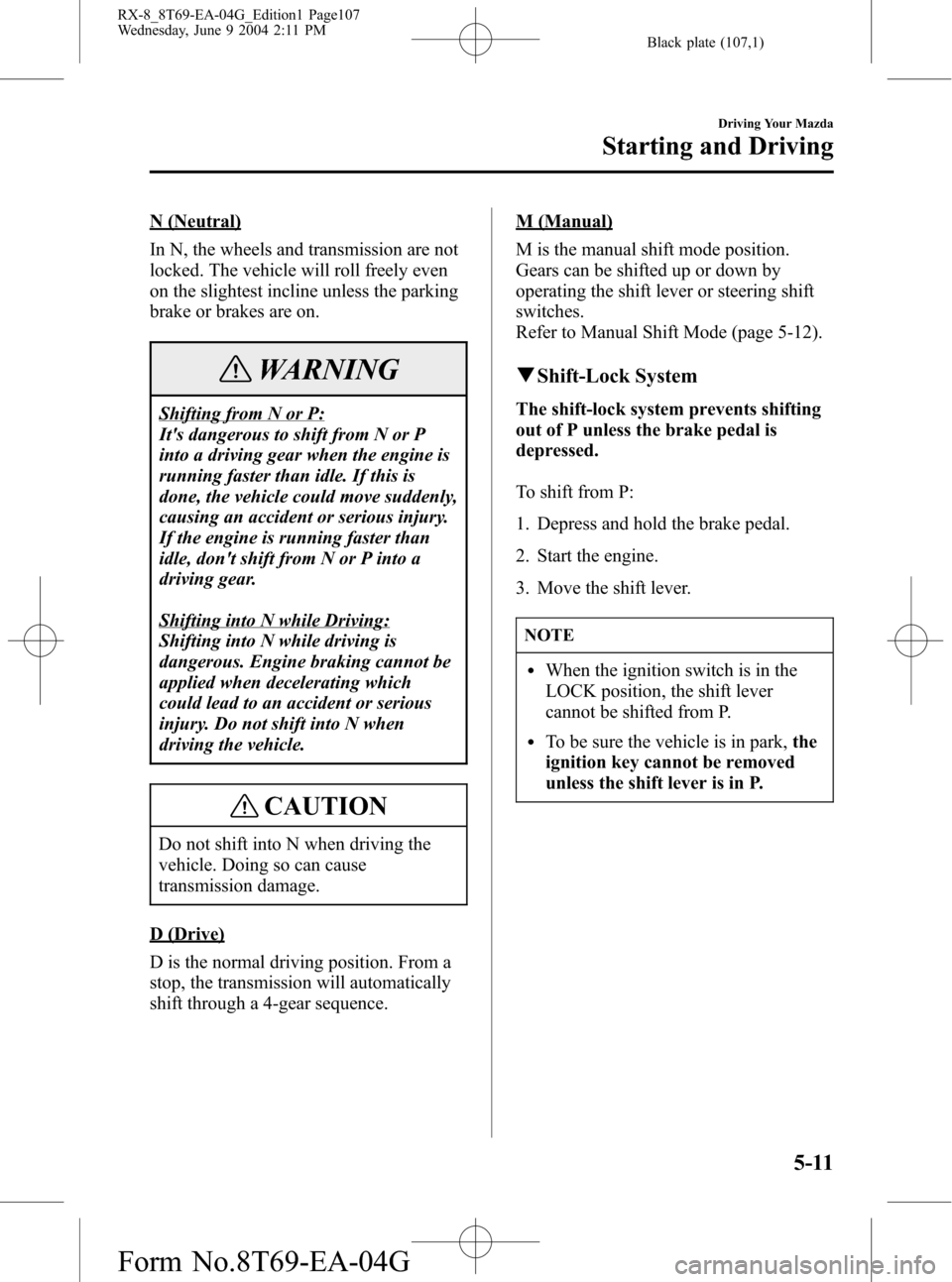
Black plate (107,1)
N (Neutral)
In N, the wheels and transmission are not
locked. The vehicle will roll freely even
on the slightest incline unless the parking
brake or brakes are on.
WARNING
Shifting from N or P:
It's dangerous to shift from N or P
into a driving gear when the engine is
running faster than idle. If this is
done, the vehicle could move suddenly,
causing an accident or serious injury.
If the engine is running faster than
idle, don't shift from N or P into a
driving gear.
Shifting into N while Driving:
Shifting into N while driving is
dangerous. Engine braking cannot be
applied when decelerating which
could lead to an accident or serious
injury. Do not shift into N when
driving the vehicle.
CAUTION
Do not shift into N when driving the
vehicle. Doing so can cause
transmission damage.
D (Drive)
D is the normal driving position. From a
stop, the transmission will automatically
shift through a 4-gear sequence.
M (Manual)
M is the manual shift mode position.
Gears can be shifted up or down by
operating the shift lever or steering shift
switches.
Refer to Manual Shift Mode (page 5-12).
qShift-Lock System
The shift-lock system prevents shifting
out of P unless the brake pedal is
depressed.
To shift from P:
1. Depress and hold the brake pedal.
2. Start the engine.
3. Move the shift lever.
NOTE
lWhen the ignition switch is in the
LOCK position, the shift lever
cannot be shifted from P.
lTo be sure the vehicle is in park,the
ignition key cannot be removed
unless the shift lever is in P.
Driving Your Mazda
Starting and Driving
5-11
RX-8_8T69-EA-04G_Edition1 Page107
Wednesday, June 9 2004 2:11 PM
Form No.8T69-EA-04G
Page 108 of 364
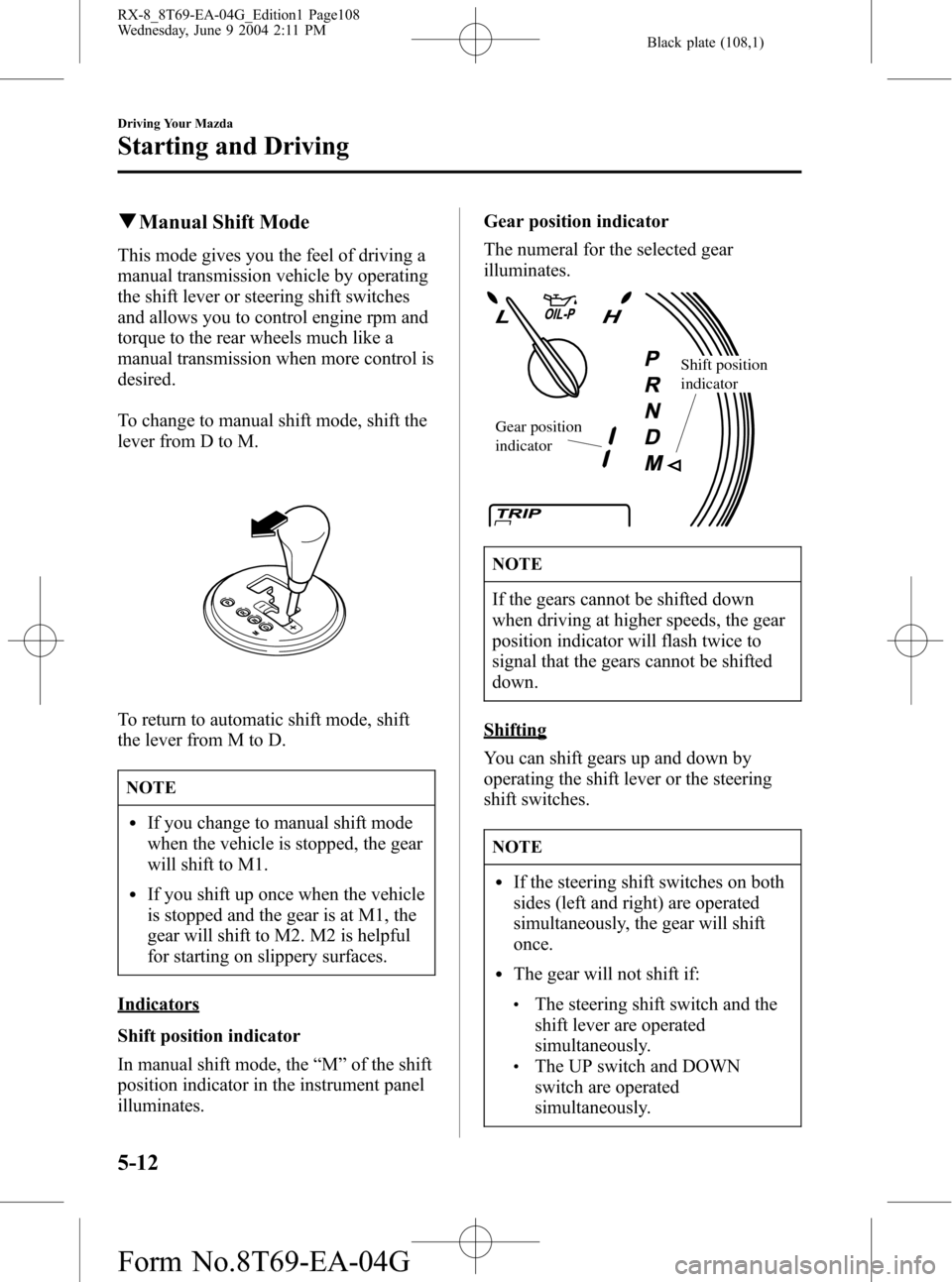
Black plate (108,1)
qManual Shift Mode
This mode gives you the feel of driving a
manual transmission vehicle by operating
the shift lever or steering shift switches
and allows you to control engine rpm and
torque to the rear wheels much like a
manual transmission when more control is
desired.
To change to manual shift mode, shift the
lever from D to M.
To return to automatic shift mode, shift
the lever from M to D.
NOTE
lIf you change to manual shift mode
when the vehicle is stopped, the gear
will shift to M1.
lIf you shift up once when the vehicle
is stopped and the gear is at M1, the
gear will shift to M2. M2 is helpful
for starting on slippery surfaces.
Indicators
Shift position indicator
In manual shift mode, the“M”of the shift
position indicator in the instrument panel
illuminates.Gear position indicator
The numeral for the selected gear
illuminates.
Gear position
indicator
Shift position
indicator
NOTE
If the gears cannot be shifted down
when driving at higher speeds, the gear
position indicator will flash twice to
signal that the gears cannot be shifted
down.
Shifting
You can shift gears up and down by
operating the shift lever or the steering
shift switches.
NOTE
lIf the steering shift switches on both
sides (left and right) are operated
simultaneously, the gear will shift
once.
lThe gear will not shift if:
lThe steering shift switch and the
shift lever are operated
simultaneously.
lThe UP switch and DOWN
switch are operated
simultaneously.
5-12
Driving Your Mazda
Starting and Driving
RX-8_8T69-EA-04G_Edition1 Page108
Wednesday, June 9 2004 2:11 PM
Form No.8T69-EA-04G
Page 109 of 364

Black plate (109,1)
Manually shifting up
(M1→M2→M3→M4)
NOTE
lWhen driving slowly, the gears may
not shift up depending on vehicle
speed.
lIn manual shift mode, gears do not
shift up automatically. Don't run the
engine with the tachometer needle in
the RED ZONE. If the tachometer
needle enters the RED ZONE, you
may feel engine-braking because the
fuel delivery will be stopped to
protect the engine. However, this
does not indicate an abnormality.
lGears may not be shifted from M1 to
M2 right after shifting the lever from
D to M. Wait a few seconds and then
shift up to M2.
lWhen depressing the accelerator
fully, the transmission will shift to a
lower gear, depending on vehicle
speed.
To shift up to a higher gear with the shift
lever, tap the shift lever back (+) once.
To shift up to a higher gear with the
steering shift switches, tap either of the
UP switches toward you once with your
fingers.
UP switches
WARNING
Hand Position When Using Steering
Shift Switches:
Putting your hands inside the rim of
the steering wheel when using the
steering shift switches is dangerous. If
the driver air bag were to deploy in a
collision, your hands could be
impacted causing injury. Keep your
hands on the steering wheel rim when
using fingers or thumbs on the
steering shift switches.
Driving Your Mazda
Starting and Driving
5-13
RX-8_8T69-EA-04G_Edition1 Page109
Wednesday, June 9 2004 2:11 PM
Form No.8T69-EA-04G
Page 111 of 364

Black plate (111,1)
WARNING
Hand Position When Using Steering
Shift Switches:
Putting your hands inside the rim of
the steering wheel when using the
steering shift switches is dangerous. If
the driver air bag were to deploy in a
collision, your hands could be
impacted causing injury. Keep your
hands on the steering wheel rim when
using fingers or thumbs on the
steering shift switches.
Shifting specification
Shifting up
If the vehicle speed is lower than the
speed specified for each gear, the gear
cannot be shifted up to a higher gear.
Gear Vehicle speed
M1→M2You can shift up to M2 whether
the vehicle is stopped or moving.
M2→M3 20 km/h (12 mph)
M3→M4 31 km/h (19 mph)
Shifting down
If the vehicle speed is higher than the
speed specified for each gear, the gear
cannot be shifted down to a lower gear.
Gear Vehicle speed
M4→M3 163 km/h (101 mph)
M3→M2 110 km/h (68 mph)
M2→M1 45 km/h (28 mph)
During deceleration, the gears shift down
automatically when speed is reduced to
the following:
Gear Vehicle speed
M4→M3 31 km/h (19 mph)
M3 or M2→M1 8 km/h (5 mph)
NOTE
If the vehicle is driven at a low speed
from a standing start while in M2, the
gear may not shift down to M1
automatically.
If the vehicle is kicked down at the
following speeds or lower, the gears shift
down automatically:
Gear Vehicle speed
M4→M3 149 km/h (93 mph)
M4→M2 56 km/h (35 mph)
M3→M2 56 km/h (35 mph)
Recommendations for shifting
Upshifting
For normal acceleration and cruising, we
recommend these shift points.
Gear Vehicle speed
M1 to M2 19 km/h (12 mph)
M2 to M3 34 km/h (21 mph)
M3 to M4 47 km/h (29 mph)
For cruising
Gear Vehicle speed
M1 to M2 18 km/h (11 mph)
M2 to M3 32 km/h (20 mph)
M3 to M4 45 km/h (28 mph)
Downshifting
When you must slow down in heavy
traffic or on a steepupgrade, downshift
before the engine starts to overwork. This
gives better acceleration when you need
more speed.
On a steepdowngrade, downshifting
helps maintain safe speed and prolongs
brake life.
Driving Your Mazda
Starting and Driving
5-15
RX-8_8T69-EA-04G_Edition1 Page111
Wednesday, June 9 2004 2:11 PM
Form No.8T69-EA-04G
Page 117 of 364

Black plate (117,1)
lPress the CANCEL button.
The system is off when the ignition is off.
NOTE
Cruise control will cancel at about 15
km/h (9 mph) below the preset speed or
below 30 km/h (19 mph).
Traction Control System
(TCS)
í
The Traction Control System (TCS)
enhances traction and safety by
controlling engine torque and breaking.
When the TCS detects driving wheel
slippage, it lowers engine torque and
operates the brakes to prevent loss of
traction.
This means that on a slick surface, the
engine adjusts automatically to provide
optimum power to the drive wheels
without causing them to spin and lose
traction.
WARNING
TCS and Unsafe Driving:
The traction control system (TCS)
cannot compensate for unsafe and
reckless driving, excessive speed,
tailgating (following another vehicle
too closely), and hydroplaning
(reduced tire friction and road contact
because of water on the road surface).
You can still have an accident. So
don't rely on the traction control
system as a substitute for safe driving.
TCS and Snow and Ice:
Driving without proper traction
devices on snow and/or ice-covered
roads is dangerous. The traction
control system (TCS) alone cannot
provide adequate traction and you
could still have an accident. Use snow
tires or tire chains and drive at
reduced speeds when roads are
covered with ice and/or snow.
Driving Your Mazda
Starting and Driving
5-21íSome models. RX-8_8T69-EA-04G_Edition1 Page117
Wednesday, June 9 2004 2:11 PM
Form No.8T69-EA-04G
Page 119 of 364
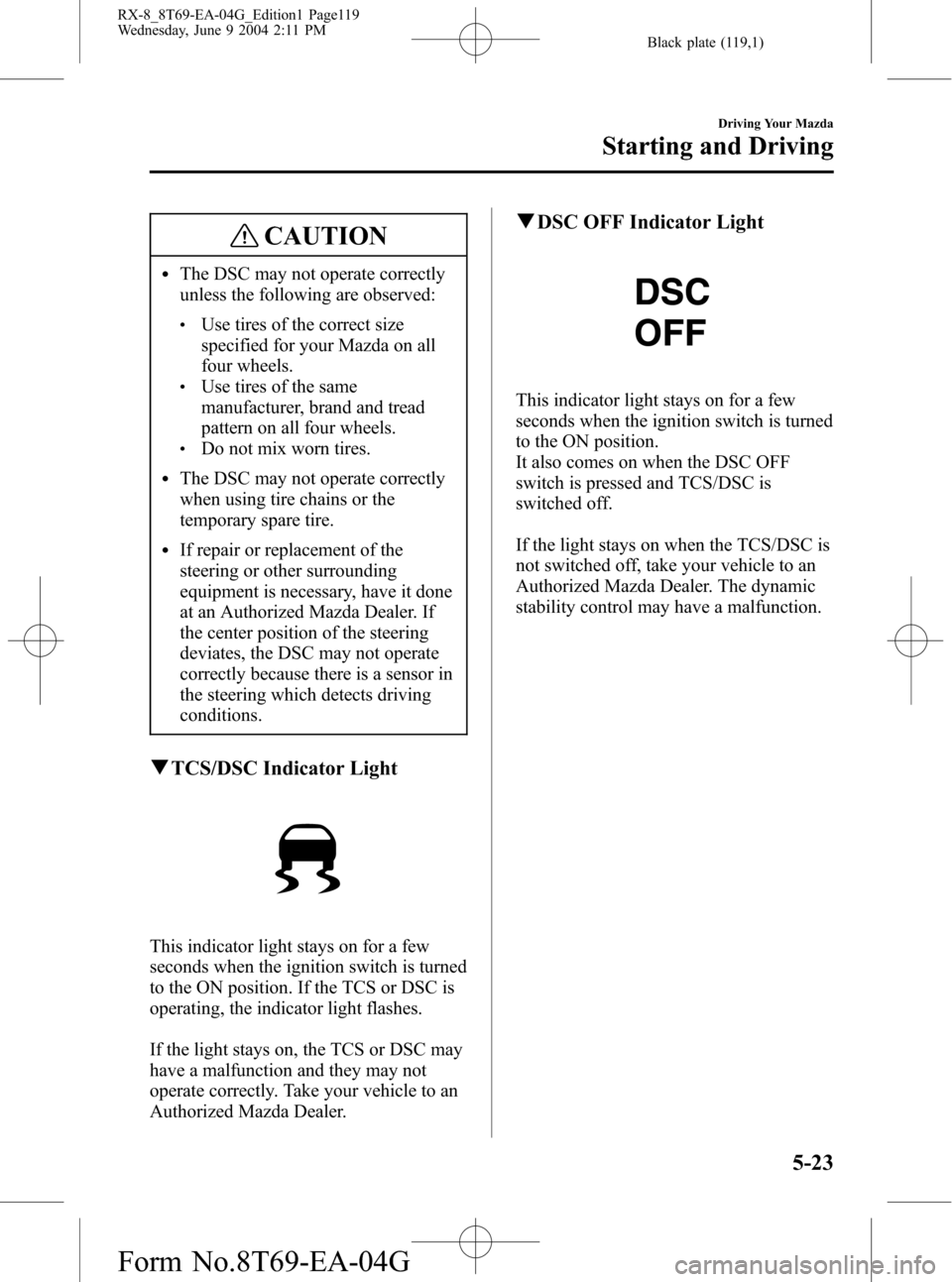
Black plate (119,1)
CAUTION
lThe DSC may not operate correctly
unless the following are observed:
lUse tires of the correct size
specified for your Mazda on all
four wheels.
lUse tires of the same
manufacturer, brand and tread
pattern on all four wheels.
lDo not mix worn tires.
lThe DSC may not operate correctly
when using tire chains or the
temporary spare tire.
lIf repair or replacement of the
steering or other surrounding
equipment is necessary, have it done
at an Authorized Mazda Dealer. If
the center position of the steering
deviates, the DSC may not operate
correctly because there is a sensor in
the steering which detects driving
conditions.
qTCS/DSC Indicator Light
This indicator light stays on for a few
seconds when the ignition switch is turned
to the ON position. If the TCS or DSC is
operating, the indicator light flashes.
If the light stays on, the TCS or DSC may
have a malfunction and they may not
operate correctly. Take your vehicle to an
Authorized Mazda Dealer.
qDSC OFF Indicator Light
This indicator light stays on for a few
seconds when the ignition switch is turned
to the ON position.
It also comes on when the DSC OFF
switch is pressed and TCS/DSC is
switched off.
If the light stays on when the TCS/DSC is
not switched off, take your vehicle to an
Authorized Mazda Dealer. The dynamic
stability control may have a malfunction.
Driving Your Mazda
Starting and Driving
5-23
RX-8_8T69-EA-04G_Edition1 Page119
Wednesday, June 9 2004 2:11 PM
Form No.8T69-EA-04G
Page 121 of 364
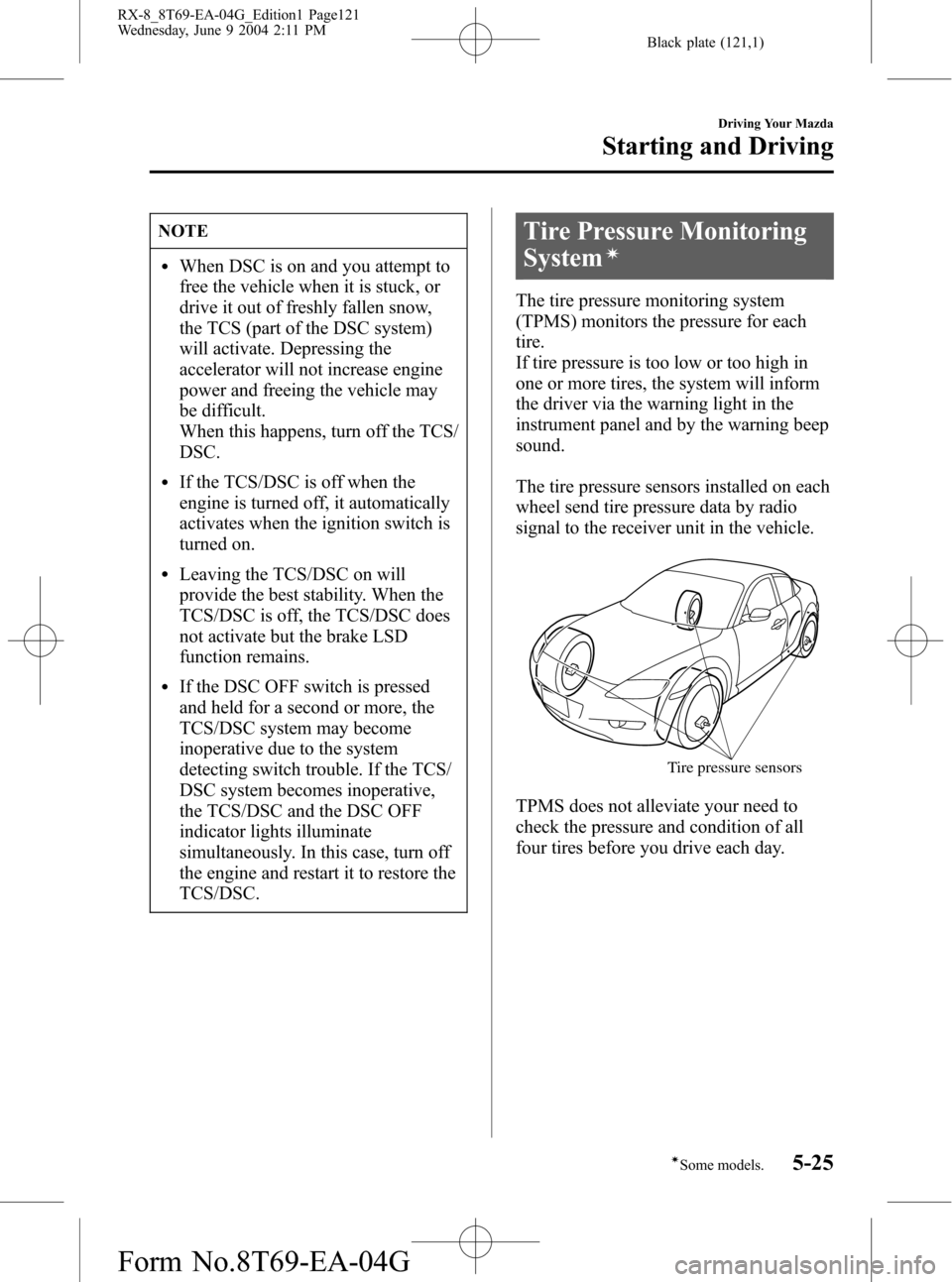
Black plate (121,1)
NOTE
lWhen DSC is on and you attempt to
free the vehicle when it is stuck, or
drive it out of freshly fallen snow,
the TCS (part of the DSC system)
will activate. Depressing the
accelerator will not increase engine
power and freeing the vehicle may
be difficult.
When this happens, turn off the TCS/
DSC.
lIf the TCS/DSC is off when the
engine is turned off, it automatically
activates when the ignition switch is
turned on.
lLeaving the TCS/DSC on will
provide the best stability. When the
TCS/DSC is off, the TCS/DSC does
not activate but the brake LSD
function remains.
lIf the DSC OFF switch is pressed
and held for a second or more, the
TCS/DSC system may become
inoperative due to the system
detecting switch trouble. If the TCS/
DSC system becomes inoperative,
the TCS/DSC and the DSC OFF
indicator lights illuminate
simultaneously. In this case, turn off
the engine and restart it to restore the
TCS/DSC.
Tire Pressure Monitoring
System
í
The tire pressure monitoring system
(TPMS) monitors the pressure for each
tire.
If tire pressure is too low or too high in
one or more tires, the system will inform
the driver via the warning light in the
instrument panel and by the warning beep
sound.
The tire pressure sensors installed on each
wheel send tire pressure data by radio
signal to the receiver unit in the vehicle.
Tire pressure sensors
TPMS does not alleviate your need to
check the pressure and condition of all
four tires before you drive each day.
Driving Your Mazda
Starting and Driving
5-25íSome models. RX-8_8T69-EA-04G_Edition1 Page121
Wednesday, June 9 2004 2:11 PM
Form No.8T69-EA-04G
Page 123 of 364

Black plate (123,1)
WARNING
Ignoring the Warning Light:
Ignoring the warning light is
dangerous, even if you know why it is
illuminated. Have the problem taken
care of as soon as possible before it
develops into a more serious situation
that could lead to tire failure and a
dangerous accident.
Warning light illuminates/Warning
beep sounds
When the warning light illuminates, and
the warning beep sound is heard (about 3
seconds), tire pressure is too low or too
high in one or more tires.
Adjust the tire pressure to the correct tire
pressure at an Authorized Mazda Dealer
or the nearest service station. Refer to the
specification charts (page 10-6).
CAUTION
When replacing/repairing the tires or
wheels or both, have the work done by
an Authorized Mazda Dealer, or the tire
pressure sensors may be damaged.
If the warning light illuminates again even
after the tire pressures are adjusted, there
may be a tire puncture.
Vehicles with Instant Mobility System
(IMS) emergency flat tire repair kit
If an emergency tire repair is needed,
repair the punctured tire with the
emergency flat tire repair kit (page 7-5).
CAUTION
Do not use non-genuine tire sealant. It
may damage the tire pressure sensor.
Vehicles with optional temporary spare
tire
If you have bought the optional temporary
spare tire, replace the punctured tire with
the temporary spare tire . Refer to the
manufacturer's instructions.
NOTE
A tire pressure sensor is not installed to
the temporary spare tire. The warning
light will flash continuously while the
temporary spare tire is being used.
Warning light flashes
When the warning light flashes, there may
be a system malfunction. Consult an
Authorized Mazda Dealer.
qSystem Error Activation
When the warning light flashes, there may
be a system malfunction. Consult an
Authorized Mazda Dealer.
A system error activation may occur in
the following cases:
lWhen there is equipment or a device
near the vehicle using the same radio
frequency as that of the tire pressure
sensors.
lWhen a metallic device such as a non-
genuine navigation system is equipped
near the center of the dashboard, which
may block radio signals from the tire
pressure sensor to the receiver unit.
Driving Your Mazda
Starting and Driving
5-27
RX-8_8T69-EA-04G_Edition1 Page123
Wednesday, June 9 2004 2:11 PM
Form No.8T69-EA-04G
Page 124 of 364
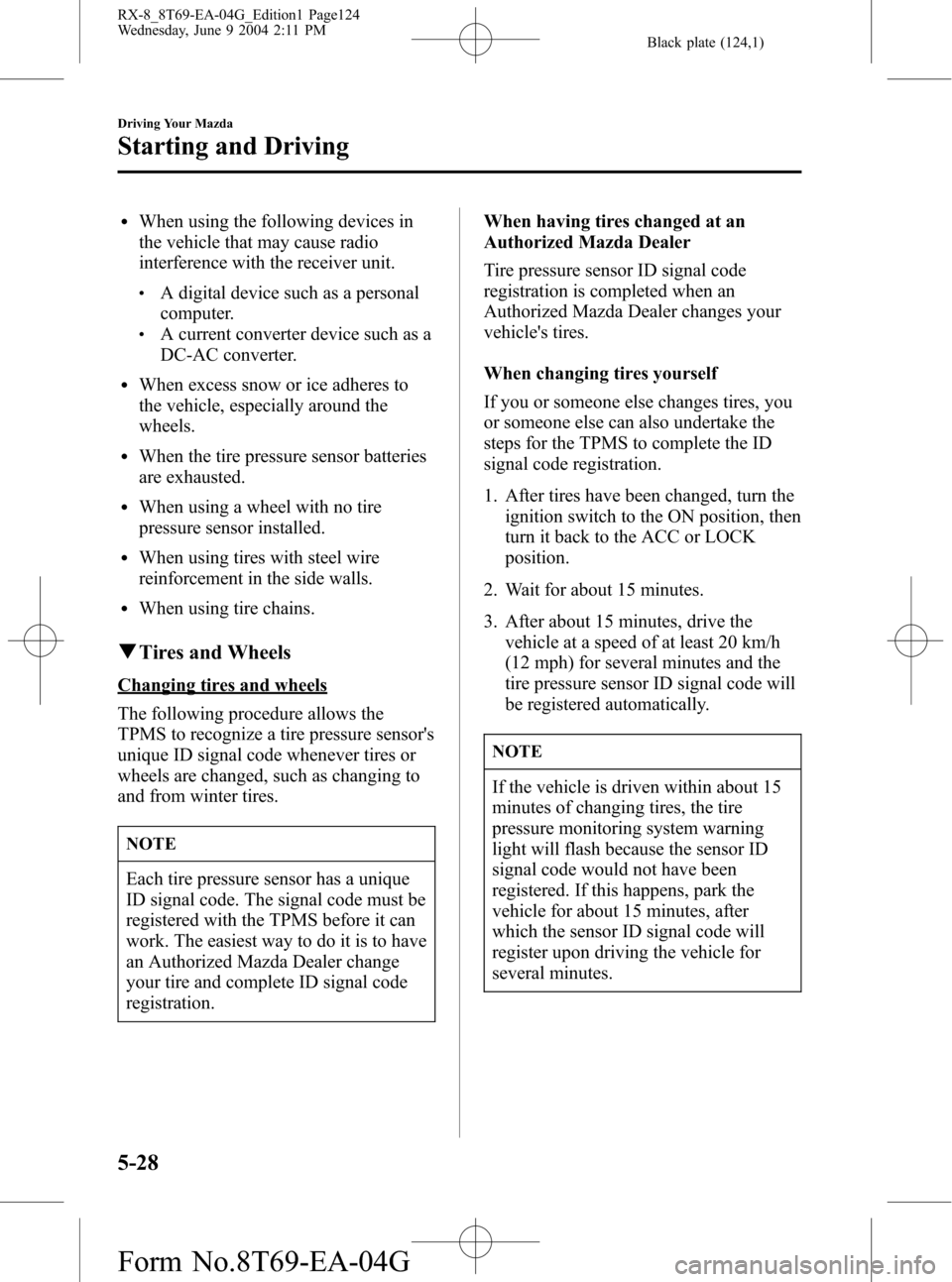
Black plate (124,1)
lWhen using the following devices in
the vehicle that may cause radio
interference with the receiver unit.
lA digital device such as a personal
computer.
lA current converter device such as a
DC-AC converter.
lWhen excess snow or ice adheres to
the vehicle, especially around the
wheels.
lWhen the tire pressure sensor batteries
are exhausted.
lWhen using a wheel with no tire
pressure sensor installed.
lWhen using tires with steel wire
reinforcement in the side walls.
lWhen using tire chains.
qTires and Wheels
Changing tires and wheels
The following procedure allows the
TPMS to recognize a tire pressure sensor's
unique ID signal code whenever tires or
wheels are changed, such as changing to
and from winter tires.
NOTE
Each tire pressure sensor has a unique
ID signal code. The signal code must be
registered with the TPMS before it can
work. The easiest way to do it is to have
an Authorized Mazda Dealer change
your tire and complete ID signal code
registration.When having tires changed at an
Authorized Mazda Dealer
Tire pressure sensor ID signal code
registration is completed when an
Authorized Mazda Dealer changes your
vehicle's tires.
When changing tires yourself
If you or someone else changes tires, you
or someone else can also undertake the
steps for the TPMS to complete the ID
signal code registration.
1. After tires have been changed, turn the
ignition switch to the ON position, then
turn it back to the ACC or LOCK
position.
2. Wait for about 15 minutes.
3. After about 15 minutes, drive the
vehicle at a speed of at least 20 km/h
(12 mph) for several minutes and the
tire pressure sensor ID signal code will
be registered automatically.
NOTE
If the vehicle is driven within about 15
minutes of changing tires, the tire
pressure monitoring system warning
light will flash because the sensor ID
signal code would not have been
registered. If this happens, park the
vehicle for about 15 minutes, after
which the sensor ID signal code will
register upon driving the vehicle for
several minutes.
5-28
Driving Your Mazda
Starting and Driving
RX-8_8T69-EA-04G_Edition1 Page124
Wednesday, June 9 2004 2:11 PM
Form No.8T69-EA-04G
Page 125 of 364

Black plate (125,1)
Replacing tires and wheels
CAUTION
lWhen replacing/repairing the tires or
wheels or both, have the work done
by an Authorized Mazda Dealer, or
the tire pressure sensors may be
damaged.
lThe wheels equipped on your Mazda
are specially designed for installation
of the tire pressure sensors. Do not
use non-genuine wheels, otherwise it
may not be possible to install the tire
pressure sensors.
Be sure to have the tire pressure sensors
installed whenever tires or wheels are
replaced.
When having a tire or wheel or both
replaced, the following types of tire
pressure sensor installation are possible.
lThe tire pressure sensor is removed
from the old wheel and installed to the
new one.
lThe same tire pressure sensor is used
with the same wheel. Only the tire is
replaced.
lA new tire pressure sensor is installed
to a new wheel.
NOTE
lThe tire pressure sensor ID signal
code must be registered when a new
tire pressure sensor is purchased. For
purchase of a tire pressure sensor and
registration of the tire pressure
sensor ID signal code, consult an
Authorized Mazda Dealer.
lWhen reinstalling a previously
removed tire pressure sensor to a
wheel, replace the grommet for the
tire pressure sensor.
Driving Your Mazda
Starting and Driving
5-29
RX-8_8T69-EA-04G_Edition1 Page125
Wednesday, June 9 2004 2:11 PM
Form No.8T69-EA-04G